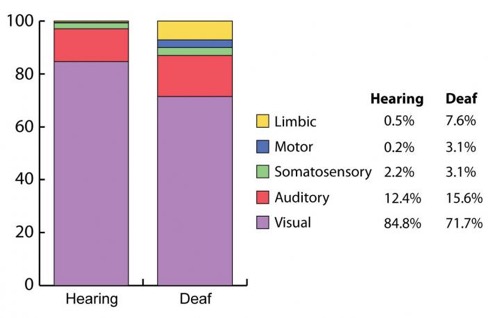Increased connections from auditory cortex to superior colliculus may support enhanced information process after hearing loss.
SOCIETY FOR NEUROSCIENCE - Cats deaf from an early age have increased outgoing connections from the auditory cortex to a midbrain region responsible for directing the animal to a particular location in its environment. The study, published in JNeurosci, is the first to examine the reorganization of outputs from the sensory cortex following hearing loss.

Distribution of corticotectal projections by modality in the cortex for the animals described in the current study (Deaf). Data from hearing animals previously reported by Butler and colleagues (2016) are included for comparison. Image courtesy of Butler, Sunstrum & Lomber, JNeurosci (2018).
Although mammals are able to see and hear early in life, the neural machinery that supports these senses develops slowly in response to input from the outside world. Such experience-dependent plasticity helps to fine-tune the animal's perceptual abilities to its environment. Without this input, the brain regions that would normally process the deprived sense are instead recruited for other purposes.
Compared to hearing cats, Blake Butler and colleagues found that cats made deaf in the first weeks of life had reduced connections from the anterior ectosylvian sulcus of the sensory cortex to the superior colliculus (SC) of the midbrain. However, the deaf cats had greater connections from other auditory areas to the SC, resulting in an overall larger input. Connections from limbic brain regions to the SC were also increased in deaf cats, which may support enhanced information processing to complement the intact senses.
###
Article: Modified origins of cortical projections to the superior colliculus in the deaf: Dispersion of auditory efferents
DOI: https:/
Corresponding author: Blake Butler (University of Western Ontario, London, Canada).
About JNeurosci
JNeurosci, the Society for Neuroscience's first journal, was launched in 1981 as a means to communicate the findings of the highest quality neuroscience research to the growing field. Today, the journal remains committed to publishing cutting-edge neuroscience that will have an immediate and lasting scientific impact, while responding to authors' changing publishing needs, representing breadth of the field and diversity in authorship.
About The Society for Neuroscience
The Society for Neuroscience is the world's largest organization of scientists and physicians devoted to understanding the brain and nervous system. The nonprofit organization, founded in 1969, now has nearly 37,000 members in more than 90 countries and over 130 chapters worldwide.
Source: https://www.eurekalert.org/pub_releases/2018-04/sfn-rob032718.php

